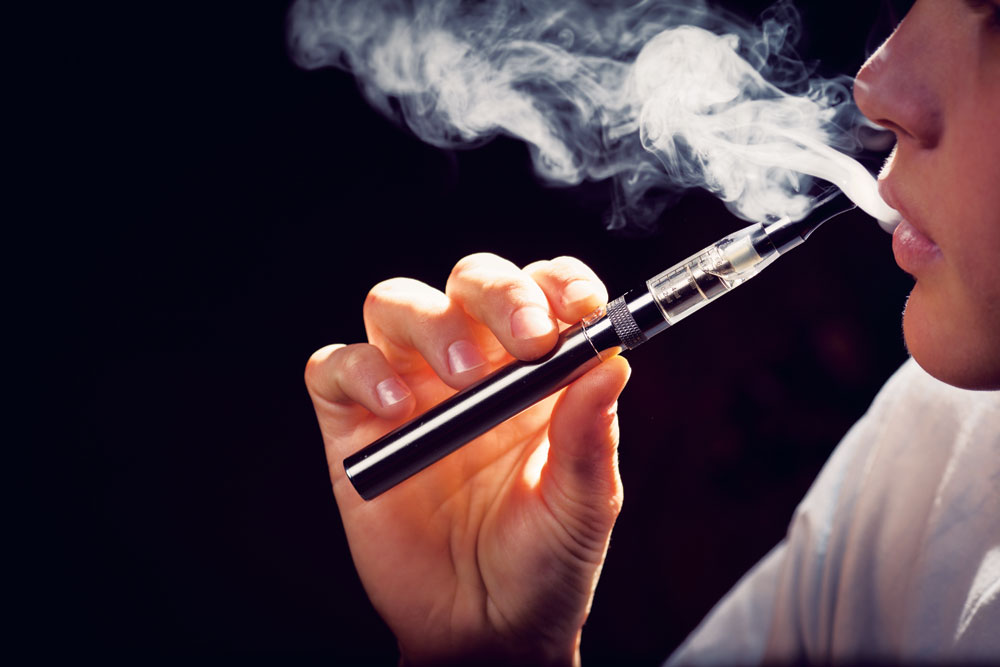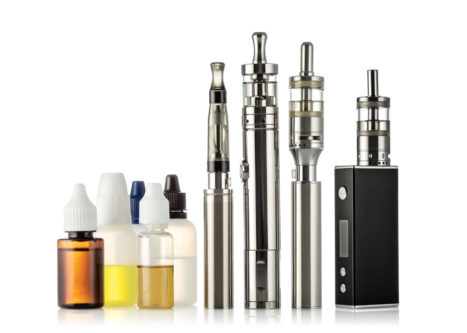
Through social media—especially Snapchat and Instagram—kids of all ages come across images of other kids vaping. And it looks pretty glamorous. Pouty-lipped teens, swathed in ethereal clouds of vapor. Images of jewel-toned vaping pens and cartridges. Celebrity sightings—there’s Kylie Jenner vaping! All these images promote the idea that vaping is cool. But what is vaping and what are its effects in adolescents?
What Is Vaping?
Vaping is the act of inhaling and exhaling vaporized liquid from an electronic cigarette or vape pen device. The liquid propylene glycol in the vape pen usually contains nicotine, but it can contain marijuana, flavorings or any combination of these elements. Vaping pens can be refilled with e-juice or e-liquid. Some have disposable cartridges, some have re-usable ones.
Vaping devices, cartridges and e-liquids can be purchased at specialized vaping stores, online or even at local convenience stores. They come in many different shapes and sizes, depending on function or fashion. Although state law prohibits people under the age of 18 from buying or possessing nicotine products, kids find ways around it, like they always have.
Some people use vape pens to inhale flavored liquids, which come in appealing varieties, like Gummi Bear, Cotton Candy or Cinnamon Doughnut. The flavors are usually inhaled with nicotine, but some kids think it’s safe to use vaping pens if the liquid doesn’t contain nicotine.
Many independent vape shops manufacture their own proprietary e-juice, but there are national brands, like Juul, that can be found in convenience stores. Juul is an e-cigarette with a high concentration of nicotine that is among the fastest-growing products in the market and very popular among teens.

Many people—kids and adults alike—believe that vaping is safer than smoking. But experts present a different picture of the issue.
Vaping has become surprisingly popular among high school and middle school students, far overtaking cigarette use in recent years. Recent research shows that 46 percent of Colorado high school students and 15 percent of Colorado middle school students have used electronic vapor products, rates far higher than traditional cigarette smoking in those groups.
Those rates are especially concerning for a behavior that many parents and educators know little about.
Ashley Brooks-Russell, an assistant professor at the Colorado School of Public Health at the University of Colorado Anschutz Medical Campus, is also the project director for the Healthy Kids Colorado Survey (HKCS). Every two years, HKCS surveys over 60,000 kids across the state about a host of health issues, including use of tobacco and electronic vapor products.
The results from the 2015 survey were surprising: “Traditional cigarette smoking is going out of style and these e-products, e-cigarettes are taking hold.” Several years ago, they didn’t even ask about vaping, but the 2017 survey, whose results will be out later this year, included 10 questions, noted Brooks-Russell. “It seemed to come out of nowhere almost.”
Risks of Vaping
Many people—kids and adults alike—believe that vaping is safer than smoking. Some believe it is a completely safe activity. But experts present a different picture of the issue.
Smoking Risk
A recent study in the American Journal of Medicine found that young adults who didn’t smoke cigarettes but used e-cigarettes were more than four times as likely as their nonvaping peers to start smoking conventional tobacco cigarettes within 18 months. Researchers involved in that study think that it could be that the highly addictive nicotine in e-cigarettes leaves users seeking a larger dose from traditional cigarettes. Another explanation is that the behavior of vaping is similar to that of smoking, thus an easy transition.
Nicotine Effects on Developing Brains
Dr. Christian Thurstone specializes in adolescent substance abuse at Denver Health. He works with youth in a clinic setting and at six school sites across the city and is concerned about the prevalence of vaping. About two-thirds of his substance abuse clients also have a tobacco dependence, and most of that is vaping, he says.
Thurstone says there is an impression that vaping is safer than smoking, and in some adult studies, it appears to be preferred. But in adolescents whose brains are developing, it is a different story. “Nicotine exposure on the developing brain is probably not a good thing,” said Thurstone. “We know from some animal studies that nicotine exposure to the developing brain causes problems with attention and impulsivity later in life.”
Effects on Wound Healing and Pulmonary Function
Dr. Frederic Deleyiannis, a plastic surgeon with UCHealth, has studied the effects of nicotine-containing e-cigarettes in the laboratory. Recent research Deleyiannis has been involved in at University of Colorado School of Medicine suggests that e-cigarettes are equally harmful as regular tobacco cigarettes in terms of wound healing and pulmonary effects.
“If you’re comparing e-cigarette vapor to tobacco smoke…they both have toxic effects on the lungs which appear to be similar,” said Deleyiannis. “This…goes along with a previously published study that shows that wound healing and skin circulation changes were detrimental.” Deleyiannis also said that the lungs of lab rats exposed to e-cigarette vapor showed similar findings of emphysema as rats exposed to tobacco smoke.
Risk of Flavorings
Many teens think that e-cigarettes that don’t contain nicotine, just flavorings, are benign, but research suggests otherwise. In fact, according to Alison Bauer, an assistant professor and toxicologist at the Colorado School of Public Health, “In the pulmonary world, the flavorings are most definitely the most concerning [aspect].”
Bauer cited a 2015 study by Harvard researcher Joseph Allen. Allen’s study found that more than 75 percent of flavored e-cigarettes and liquid refills contained a flavoring compound called diacetyl. Diacetyl and other flavoring compounds are linked to a lung disease called bronchiolitis obliterans, known informally as “Popcorn Lung” because it was found in workers at microwave popcorn processing facilities who had inhaled the artificial butter flavoring that contained diacetyl.
Some cutting edge research also suggests that the flavorings affect how users inhale—how many puffs, the length of the average of the puff, and the force of the average draw. “All of these aspects are dependent on flavoring,” said Adam Lippert, an assistant professor of sociology at UC Denver. Appealing flavorings can lead to longer, stronger puffs, which can heat up the vaporizing liquid. This in turn produces a formaldehyde compound, one that is many times more carcinogenic than those found in regular cigarettes, said Lippert.
Addressing the Problem
Parents
Parents who have found their teens—or tweens—vaping have cause for concern, says Thurstone, even if their child tells them they are just inhaling “vape liquid” or “essential oils.” Not only do the flavorings pose a health threat, but “I’ve had a lot of patients sneak in nicotine to it, sneak marijuana into it. I’m sure you could probably sneak in other things,” said Thurstone. “It seems like a slippery slope to me.”

Vaping devices come in many shapes. Larger ones generally produce more vapor. Most can be refilled with e-juices that come in different flavors and usually contain nicotine, or marijuana.
So what should parents do if they find a stash of vape pens, e-juice or cartridges in their kid’s backpack? Thurstone says that families should take it seriously, first of all, and then talk to their children, not merely punish them. He recommends parents take “an empathic approach,” one where they seek to understand the behavior and then work with the child to set expectations and change. “We know that parents have great influence over their kids and substance use: by monitoring, by setting forth expectations and by having a positive relationship,” said Thurstone.
Schools
Research by Lippert shows that school settings are a significant predictor of vaping behavior in adolescents. “Students who attend schools where vaping is more…common are not only more likely to vape, but they’re less likely to see significant harm associated with vaping, they’re less likely to view e-cigarettes as habit-forming devices and, among those who haven’t done vapes…they’re more likely to anticipate vaping in the future,” he noted. In other words, a permissive or tolerant school culture can promote vaping behavior in adolescents.
But there is much that can be done to combat vaping culture in schools. “First, we need to get the information out there that vaping is not a safe alternative to smoking, especially for young people,” said Thurstone. “We need to follow it up…figure out why they’re doing it and what can be done with it. We know for a fact that behavioral interventions around smoking for young people are effective…you motivate kids to make positive change and you give them skills to make that change.”




0 Comments